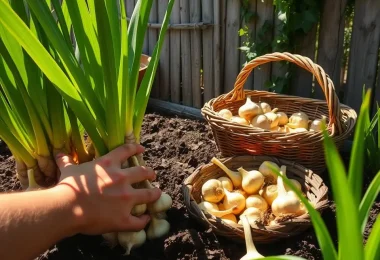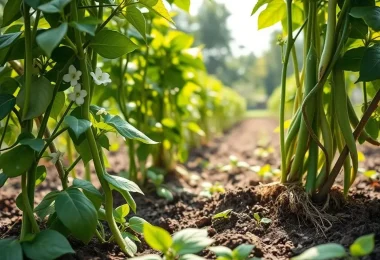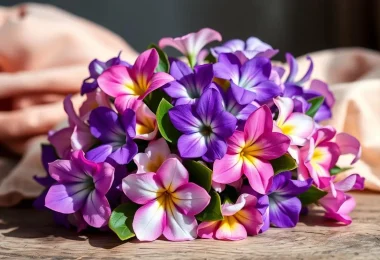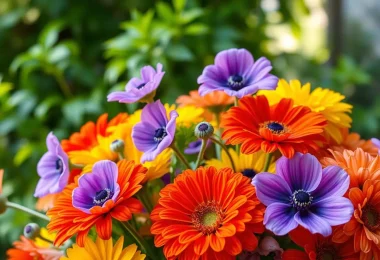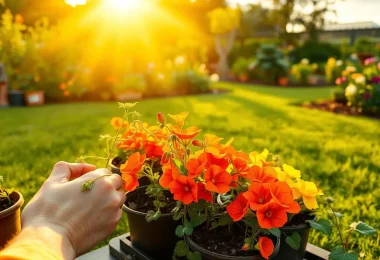In the British countryside, a shrub stands out with its white blossoms and thorny branches. This is the blackthorn, loved by gardeners and nature lovers. It’s a hidden gem, offering both beauty and practical uses, like its tasty fruits.
The blackthorn grows well in UK hedgerows and woodlands. It’s hardy and fits many environments. This guide will explore its history, how to grow it, and its many uses. We’ll uncover the magic of the blackthorn together.
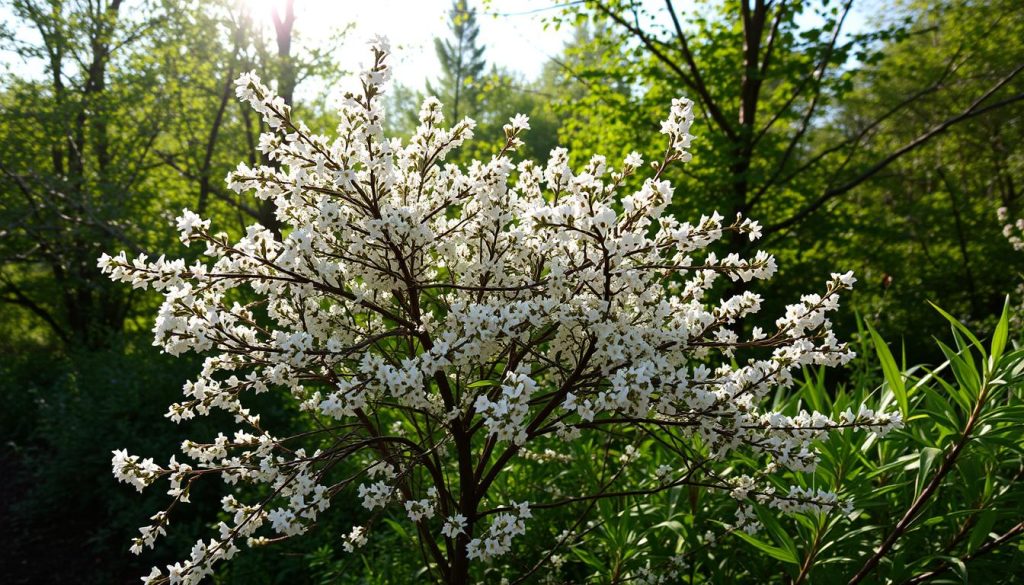
Key Takeaways
- Blackthorn is a captivating shrub with a rich history and cultural significance in the United Kingdom
- The plant offers a wealth of practical and aesthetic benefits, from its tart yet delicious fruits to its ornamental appeal
- Blackthorn is a hardy and versatile shrub that can thrive in a variety of environments, making it a popular choice for British gardens and landscapes
- This guide will explore the history, cultivation, and diverse uses of the blackthorn, unlocking the magic of this hidden gem
- Blackthorn’s adaptability and versatility make it a valuable addition to the British garden, with a range of applications and benefits
Introducing the Blackthorn: A Unique and Captivating Shrub
The blackthorn (Prunus spinosa) is a deciduous shrub from Europe and parts of Asia. It’s known for its striking look and value in British gardens. It grows well in many soils and climates, loved by gardeners and landscapers.
Its dense, thorny branches make the blackthorn look rugged and mysterious. But, it also has delicate white blossoms in spring. These blossoms appear before the leaves, creating a stunning sight.
| Characteristic | Description |
|---|---|
| Growth Habit | Sprawling, multi-stemmed shrub with a dense, thorny structure |
| Foliage | Deciduous, oval-shaped leaves that turn reddish-purple in autumn |
| Flowers | Profuse white blossoms that appear before the leaves in early spring |
| Fruit | Small, dark-coloured drupes (plums) that ripen in late summer |
The blackthorn is versatile and popular. It can stand alone, form a dense hedge, or be trained as an espalier. It grows well in different soils and some shade, fitting many garden types.
“The blackthorn is a plant of striking beauty and enduring resilience, capturing the essence of the British countryside in a single captivating shrub.”
Whether you’re new to gardening or experienced, the blackthorn will amaze you. Its mix of ruggedness and elegance makes it a garden highlight.
The History and Origins of the Blackthorn
The blackthorn shrub has a long history in Britain and Europe. It comes from the Mediterranean. This plant has been important in many cultures for centuries.
Blackthorn’s Traditional Uses and Cultural Significance
The blackthorn is more than just a pretty plant. It has been used for practical things for a long time. In rural areas, it was used for fencing and hedgerows because it’s strong.
The wood of the blackthorn is also very useful. It’s used to make tools, walking sticks, and more. This shows how valuable the blackthorn is.
The blackthorn has a special place in culture too. In old times, it was part of rituals and stories. People believed its thorns could keep away evil spirits. Today, it’s still important in many traditions.
- Blackthorn wood was valued for its strength and used in the creation of tools and walking sticks.
- The plant’s thorns were believed to offer protection against evil spirits and negative forces.
- Blackthorn has been a staple in rural fencing and hedgerows, providing a sturdy and impenetrable barrier.
“The blackthorn’s distinctive thorns were thought to offer protection against evil spirits and harmful influences.”
The blackthorn’s history and cultural importance still fascinate people today. Its lasting presence in gardens shows its timeless charm.
Identifying the Blackthorn: Distinctive Features and Characteristics
Spotting the blackthorn in your garden is easy thanks to its standout features. It’s a dense, thorny shrub that can grow up to 5 metres tall. This makes it a beautiful addition to any garden.
The blackthorn’s bark is dark grey or black, and its thorns are sharp and needle-like. But the real beauty is its delicate white flowers. These bloom in early spring, before the leaves come out.
Knowing how to spot the blackthorn is key for gardeners. Its strong growth, thorns, and beautiful flowers make it a favorite. It stands out among blackthorn, gardening, and garden plants.
| Characteristic | Description |
|---|---|
| Growth Habit | Dense, thorny shrub up to 5 metres tall |
| Bark | Dark grey or black in colour |
| Thorns | Sharp, needle-like thorns |
| Flowers | Delicate white blooms in early spring |
By learning about these features, gardeners can easily spot and use the blackthorn in their gardens. This unlocks its full beauty and charm.
The Blackthorn’s Versatile Growth Habits and Adaptability
The blackthorn is an amazing garden plant. It can grow well in many different places. It likes various soils and can handle both sun and shade.
This makes it a great choice for many gardens in Britain.
Choosing the Right Planting Location for Blackthorn
When picking a spot for your blackthorn, think about a few things. First, check how much sun the area gets. Blackthorn does well in sunny and shady spots, but it loves at least 6 hours of direct sun.
Soil type is also key. Blackthorn likes soil that drains well and is slightly acidic. If your soil is heavy clay, add organic matter to help it drain better. Sandy or chalky soil is fine with little prep.
Also, consider the space. Blackthorn can grow up to 4 metres tall and wide. Make sure it has enough room to spread out.
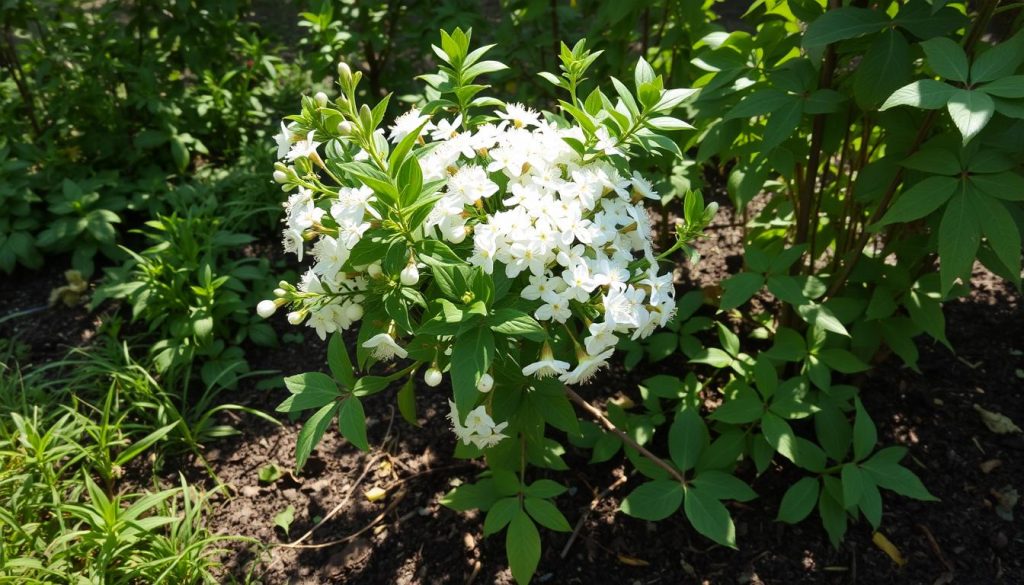
Choosing the right spot for your blackthorn ensures it grows well. It will become a beautiful part of your garden for years.
Cultivating and Caring for Blackthorn in Your Garden
Blackthorn is a captivating addition to any garden. It needs careful cultivation and care to thrive. By following the right planting and maintenance steps, your blackthorn shrub will flourish.
Start by choosing the right spot for your blackthorn. Make sure the soil drains well and gets enough sunlight. Add organic matter to the soil to give your plant the nutrients it needs.
Planting blackthorn requires some finesse. Dig a hole that’s a bit bigger than the plant’s root ball. Place the shrub at the same depth as before. Backfill the hole, firming the soil to prevent air pockets. Give each blackthorn plant enough space to grow.
Ongoing Blackthorn Maintenance
After planting, keeping your blackthorn healthy is key. Prune it regularly to shape and promote new growth. Prune in late winter or early spring, removing dead or damaged branches. Don’t over-prune, as it can stress the plant.
Watering is also vital. Keep the soil moist in the first year after planting. Once established, blackthorn can handle some drought. Still, water it during long dry spells.
Watch out for pests and diseases. Check your blackthorn often for signs of trouble. Deal with any issues quickly to stop them from spreading.
By following these tips, you’ll have a thriving blackthorn shrub. It will add charm and interest to your garden. Let blackthorn become a cherished part of your outdoor space.
The Many Benefits of Growing Blackthorn
Growing blackthorn in your garden brings many advantages. Its stunning looks and useful features make it a great choice. The plant’s beautiful flowers, sour fruit, and thorny branches add beauty and function to your garden. It’s also very flexible, fitting well into different garden designs.
Blackthorn’s Ornamental Appeal and Garden Design Potential
The blackthorn shrub is a standout in any garden. Its white or pink flowers bloom early in spring, often before the leaves come out. These flowers create a beautiful contrast against the dark, twisted branches.
After the flowers go, the blackthorn’s green leaves and thorns become the main attraction. They add texture and interest to your garden beds and borders.
Blackthorn can be used in many ways in your garden. It’s perfect as a focal point, hedge, or specimen plant. Its compact size and ability to be pruned make it great for formal hedges or adding structure to your landscape. The thorns also make it useful for creating strong barriers or security around your garden.
| Ornamental Benefit | Design Application |
|---|---|
| Striking spring blossoms | Focal point, specimen plant |
| Glossy foliage and thorns | Hedgerows, borders, security plantings |
| Compact, dense growth habit | Formal hedges, screening |
By adding blackthorn to your garden, you can create a beautiful and useful outdoor space. It’s sure to impress anyone who sees it.
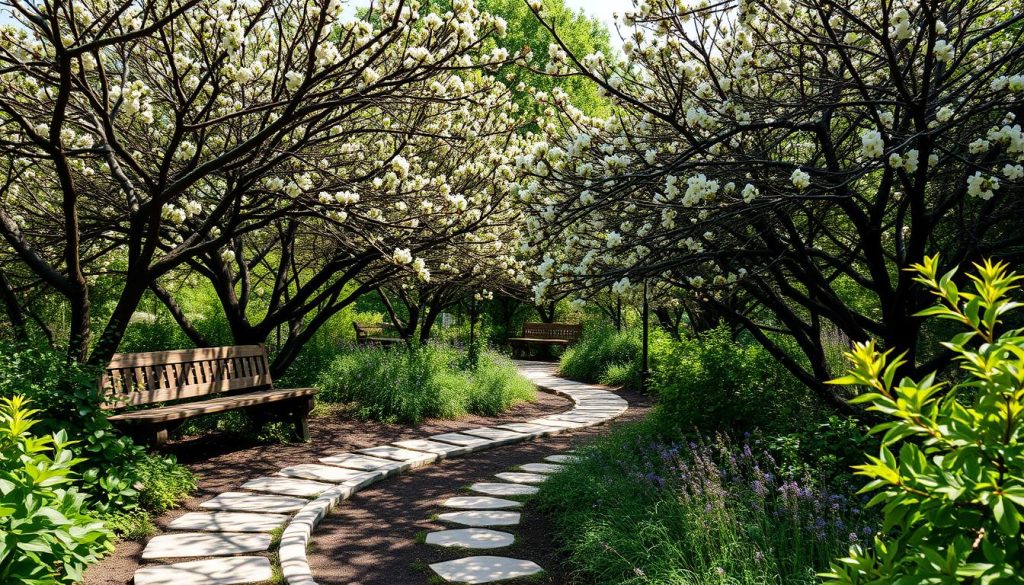
“Blackthorn is a true garden gem, offering both ornamental appeal and practical benefits to the discerning gardener.”
Pruning and Maintaining Blackthorn for Optimal Health
Keeping your blackthorn plants healthy is key to their success. Using the right pruning methods and regular care ensures they thrive. This makes your garden more beautiful.
Mastering the Art of Blackthorn Pruning
Pruning blackthorn is vital and should be done at the right time. Prune in late winter or early spring, before new growth starts. This encourages strong shoots and keeps the plant’s shape.
- Use sharp, clean pruning shears for clean cuts.
- Remove dead, damaged, or crossing branches for better air and light.
- Thin the plant’s interior to prevent overcrowding and encourage new growth.
- Trim overgrown branches to keep the blackthorn’s shape.
Ongoing Blackthorn Care and Maintenance
There’s more to keeping your blackthorn healthy than just pruning:
- Watch for pests or diseases and act quickly if you find any.
- Feed the plant with a balanced, slow-release fertiliser in early spring.
- Water during dry spells to keep the soil moist but not soggy.
- Mulch around the base to keep moisture in and weeds out.
By following these tips, your blackthorn will be lush, vibrant, and healthy. It will make your garden more beautiful for years.
“Proper care and maintenance are the keys to a thriving blackthorn plant that will bring joy and beauty to your garden.”
Blackthorn in the Wild: Habitat and Ecological Importance
The blackthorn is more than just a garden plant. It’s a key part of Britain’s natural world. Found in hedgerows, woodlands, and scrublands, it offers a home and food for many animals.
Its thorny branches are perfect for birds like finches and thrushes. The leaves and berries feed small mammals like voles and hedgehogs. Also, its flowers attract bees and butterflies, helping to keep the ecosystem diverse.
The blackthorn is also good for the soil. It’s tough and can handle drought, helping to keep the soil in place. Its roots hold the soil together, making the landscape more stable and healthy.
| Wildlife Supported by Blackthorn | Ecological Benefits Provided by Blackthorn |
|---|---|
| Birds (finches, warblers, thrushes) Small mammals (voles, mice, hedgehogs) Pollinating insects (bees, butterflies) | Habitat and nesting sites Food source (berries and flowers) Soil stabilisation and erosion control |
Knowing how important blackthorn is in the wild helps us see its bigger role. It supports the natural world of Britain. By protecting and using blackthorn in our landscapes, we can create a better environment for all.
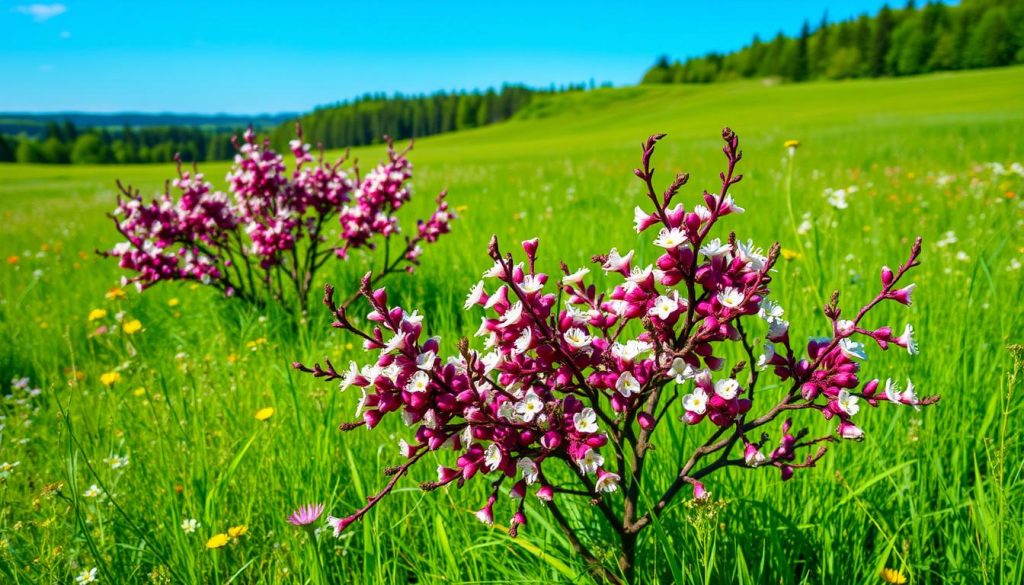
Harnessing the Power of Blackthorn: Traditional and Modern Uses
The blackthorn is more than just a pretty face in gardens. It has been a cornerstone of British culture for ages. It’s used in fencing, tool-making, and even in old tales and herbal remedies. This plant is a treasure trove for gardeners and nature lovers.
Culinary Delights: Blackthorn’s Edible Fruits and Flavours
The blackthorn’s fame comes from its edible sloes. These small, dark-blue berries are perfect for jams, preserves, and even sloe gin. Their tart taste makes them a hit in British cooking, adding a special kick to many dishes.
| Traditional Uses of Blackthorn | Modern Uses of Blackthorn |
|---|---|
| Fencing and tool-making Herbal remedies Folklore and cultural significance | Culinary applications (sloe gin, jams, preserves) Ornamental landscaping Ecological benefits (wildlife habitat, erosion control) |
The blackthorn’s story is one of enduring power and versatility. It charms gardeners and nature lovers today just as it did centuries ago. Whether you want to bring traditional charm to your garden or explore its culinary wonders, the blackthorn has much to offer.
“The blackthorn’s edible fruits, known as sloes, have been a beloved ingredient in British cuisine for centuries, adding a unique and tantalising twist to a variety of sweet and savoury dishes.”
Incorporating Blackthorn into Your Landscaping
Gardeners and landscapers can use blackthorn to make outdoor spaces look great and work well. It’s perfect for hedgerows, as a single plant, or in mixed borders. Knowing how it grows and looks helps homeowners make their gardens better.
Blackthorn is great for English-style hedgerows. Its thorns and dense growth make it perfect for natural barriers. These hedges offer privacy, protect from wind, and add a rustic charm.
For a standout feature, use blackthorn as a single plant. Its unique shape and white flowers in spring add magic to any garden. Place it near seating or paths to create a focal point.
Blackthorn also fits well in mixed borders. It adds its own look with leaves, flowers, and berries. Pair it with plants that grow well together for a balanced and beautiful garden.
When adding blackthorn to your garden, think about its growth and care. It grows fast and needs regular pruning. Also, its thorns can be a safety risk, so plan its placement carefully.
By carefully adding blackthorn to your garden, you can enjoy its beauty and benefits. It makes your outdoor space enchanting and showcases the beauty of this special shrub.
Companion Planting: Enhancing Your Garden with Blackthorn
The blackthorn shrub adds beauty to any garden. It’s also great as a companion plant, improving your garden’s look and health. By choosing the right plants to grow with blackthorn, you can make your garden more interesting and balanced.
Blackthorn is easy to grow in different conditions. It works well with colourful flowers or plants that help wildlife. This makes it easy to fit into your garden’s design.
Blackthorn and Flowering Companions
The blackthorn’s dark branches look great with many flowers. Try growing it with:
- Colourful lupins
- Fragrant lavender
- Cheerful sunflowers
These plants make your garden look lively and balanced. They highlight the blackthorn’s beauty while adding to the garden’s overall look.
Blackthorn and Ecological Plantings
Blackthorn is great for gardens that help wildlife. It’s perfect with:
- Native wildflowers to attract pollinators
- Robust hedgerow species to provide shelter and food for local fauna
- Edible berry-producing shrubs to support local bird populations
Adding blackthorn to these gardens boosts their ecological value. It also makes your garden more interesting and beneficial for wildlife.
Blackthorn is versatile and can enhance your garden in many ways. It can make your garden look better or help the environment. Either way, it’s a valuable addition to your outdoor space.
| Blackthorn Companion Plants | Benefits |
|---|---|
| Lupins, Lavender, Sunflowers | Vibrant colour contrast, harmonious display |
| Native Wildflowers, Hedgerow Species, Berry-producing Shrubs | Supports local wildlife, enhances ecological value |
By adding blackthorn to your garden, you can make it beautiful and eco-friendly. It celebrates the unique qualities of this versatile shrub.
Troubleshooting Common Issues with Blackthorn Cultivation
Blackthorn is a hardy and easy-to-care-for garden plant. Yet, gardeners might face some challenges. Knowing how to deal with pests, diseases, and environmental stresses is key. This way, you can keep your blackthorn plants healthy and thriving.
Pest Infestations
Pests like aphids, scale insects, and caterpillars can harm blackthorn. They eat the leaves and stems. It’s important to check your plant often and act fast if you see any problems.
Using natural pest control methods is a good idea. This includes introducing beneficial insects or using organic sprays. These methods can help keep pests under control.
Disease Outbreaks
Blackthorn can get fungal diseases like rust, leaf spot, and canker. These can cause leaves to fall off early and even kill the plant. It’s crucial to act quickly to prevent this.
Good air flow, pruning, and fungicidal treatments can help. These steps can stop diseases from spreading and keep your plant healthy.
Environmental Stress
Blackthorn can face challenges like drought, frost, or too much water. Planting it in the right spot with good drainage helps. Also, watering it during dry spells is important.
Mulching around the plant keeps the soil moist. It also protects the roots from extreme temperatures.
| Common Issue | Possible Causes | Recommended Solutions |
|---|---|---|
| Pest Infestations | Aphids, scale insects, caterpillars | Introduce beneficial insects, apply organic insecticidal sprays |
| Disease Outbreaks | Rust, leaf spot, canker | Maintain good air circulation, prune affected areas, apply fungicidal treatments |
| Environmental Stress | Drought, frost, excessive moisture | Ensure well-draining soil, provide supplementary watering, mulch around the base |
By tackling these common problems, you can keep your blackthorn plants healthy. This way, you can enjoy their beauty and benefits for years to come.
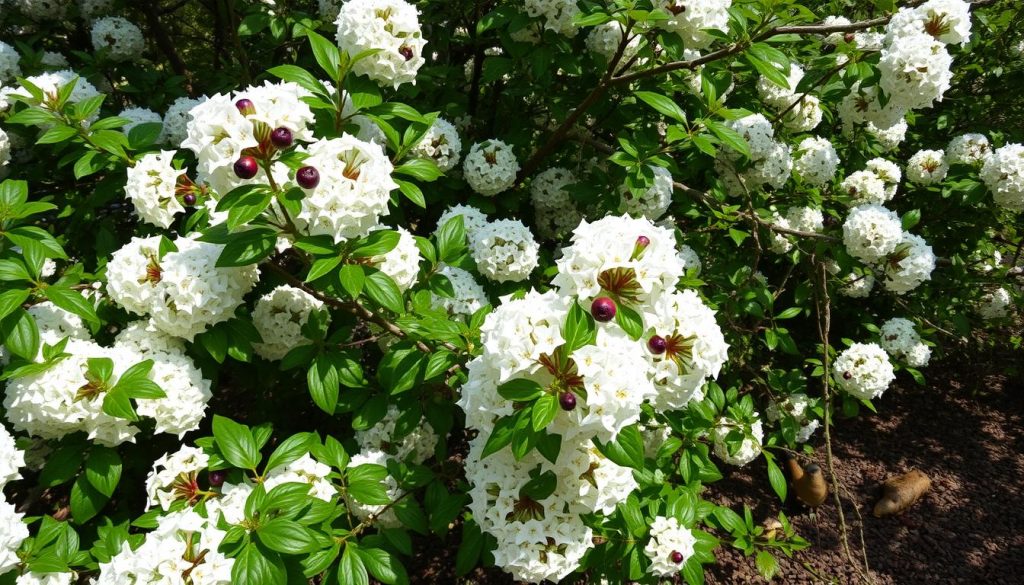
Blackthorn Cultivars: Exploring the Diverse Range of Varieties
The blackthorn is a fascinating shrub with many cultivars and varieties. Each one has its own special traits and growth patterns. Whether you want a small, compact shrub or a larger one, there’s a blackthorn for every garden.
The ‘Purpurea’ cultivar has deep purple leaves, adding drama to your garden. The ‘Pygmaea‘ is great for small spaces, growing only 1-2 metres tall. The ‘Plena’ variety attracts wildlife with its double flowers and lots of nectar.
| Cultivar | Characteristics | Potential Uses |
|---|---|---|
| Purpurea | Deep purple foliage | Ornamental garden feature, hedging |
| Pygmaea | Compact, dwarf habit (1-2 m tall) | Containers, small gardens, border plant |
| Plena | Double-flowered, wildlife-friendly | Pollinator-attracting, ornamental |
There are many more blackthorn varieties, each with its own special features. By exploring these options, gardeners can find the perfect blackthorn for their garden. It could be for beauty, wildlife, or practical uses.
With so many blackthorn varieties to choose from, the possibilities are endless. Whether you love its beauty, its wildlife appeal, or its uses, the blackthorn is a great choice for any garden.
Conclusion: Embracing the Magic of Blackthorn in Your Outdoor Space
The blackthorn is a remarkable plant that should be in every British garden. It’s not just beautiful; it’s also useful and good for the environment. This hardy shrub can make any outdoor area better.
Knowing the blackthorn’s history and importance helps gardeners care for it. They can make their gardens special by adding this plant. This way, they get to enjoy its beauty and benefits for years.
The blackthorn is great for gardens because of its looks, support for wildlife, and uses in cooking and medicine. It’s a treasure for British gardeners. By using the blackthorn in their gardening, they can connect more with nature and enjoy its beauty.
FAQ
What is the blackthorn and where does it originate from?
The blackthorn, or Prunus spinosa, is a shrub from Europe and Asia. It’s known for its dense thorns and white flowers in spring.
What are the traditional uses and cultural significance of the blackthorn?
The blackthorn has a long history. It was used for fencing and making tools. It also played a role in ancient rituals and superstitions.
How can I identify the blackthorn in my garden?
Identifying the blackthorn is easy. It’s a thorny shrub up to 5 metres tall. Its dark bark and sharp thorns are clear signs. The white flowers in spring are also distinctive.
What are the growth habits and adaptability of the blackthorn?
The blackthorn grows well in many places. It likes different soils and light conditions. This makes it great for British gardens.
How do I cultivate and care for blackthorn in my garden?
To grow blackthorn, start with good soil and space. Prune, water, and protect it to keep it healthy. This makes your garden look better.
What are the benefits of growing blackthorn in my garden?
Blackthorn adds beauty and function to gardens. Its flowers, fruit, and thorns are interesting. They make your garden more attractive and useful.
How do I prune and maintain blackthorn for optimal health?
Prune blackthorn regularly to control its size and shape. This encourages new growth. Watch for pests and diseases to keep it healthy.
What is the ecological importance of blackthorn in the wild?
In the wild, blackthorn is crucial for wildlife. It provides food and shelter for birds, mammals, and insects in hedgerows and woodlands.
What are the traditional and modern uses of the blackthorn?
Blackthorn has many uses. It’s used in fencing, tool-making, and in folklore. Its sloes are also used in jams and sloe gin.
How can I incorporate blackthorn into my landscaping?
Use blackthorn in hedgerows or as a standalone plant. It adds beauty and function to gardens and landscapes.
What are some common companion plants for blackthorn?
Blackthorn grows well with other plants. Choose plants that complement its beauty. This creates stunning garden displays.
What are some common issues with blackthorn cultivation and how can I address them?
Blackthorn is mostly easy to grow. But, watch out for pests, diseases, and environmental problems. Knowing how to deal with these issues helps keep your blackthorn healthy.
What are the different cultivars and varieties of blackthorn available?
There are many blackthorn varieties. Choose from compact to large plants. Find the one that fits your garden best.



